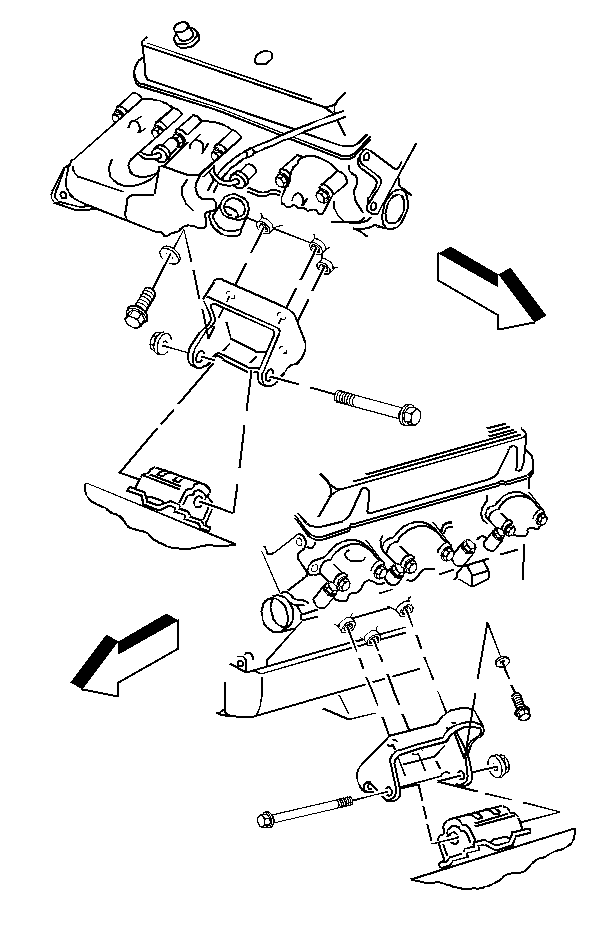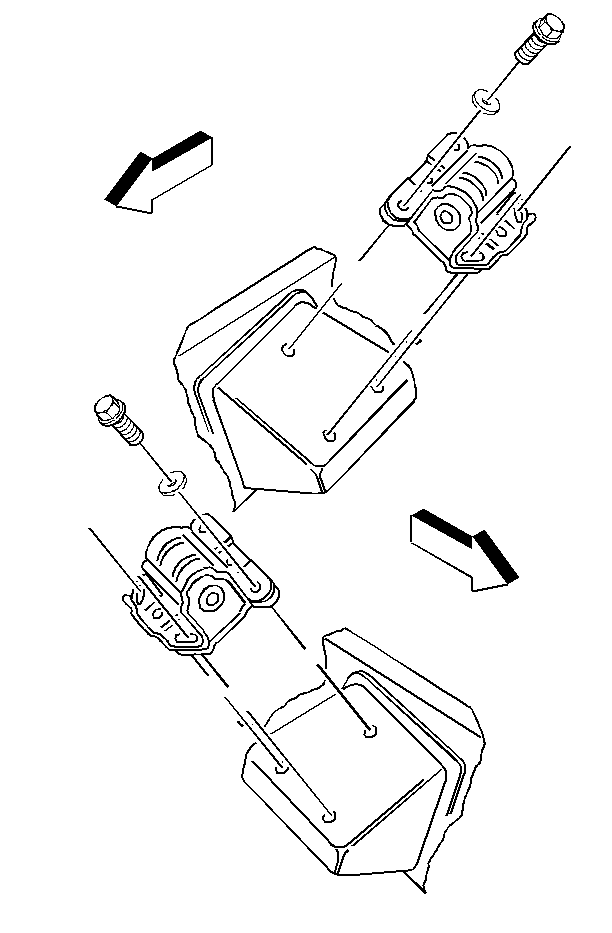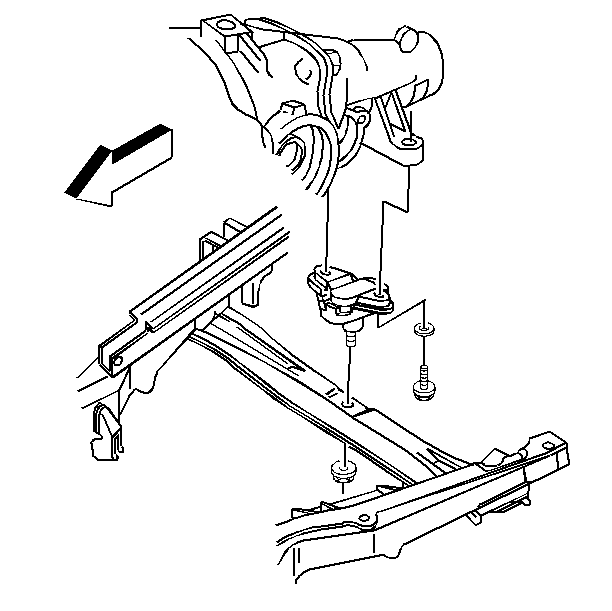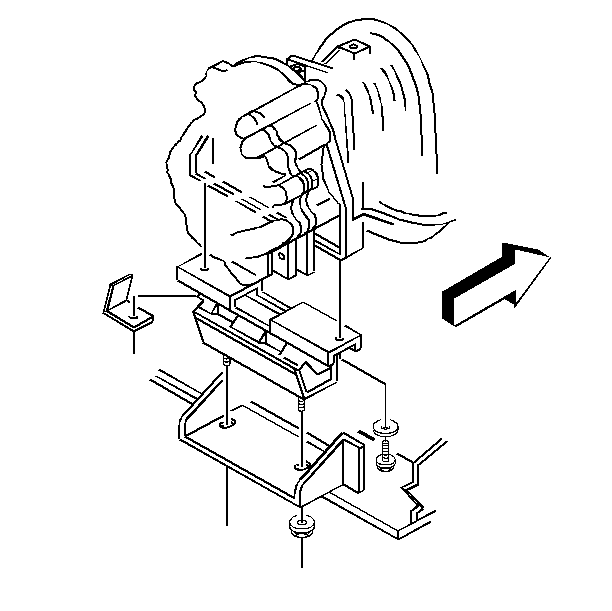Engine Mount Replacement Front Bracket RWD
Removal Procedure
The 4.3L engine uses hollow, Loctite coated engine mount bolts in order to retain the engine mount bracket to the engine block. The purpose of these hollow bolts is to allow the engine assembly to break free of its mounts in a very extreme frontal collision situation.
Important: If the vehicle has been in a collision, inspect the hollow mount bolts for signs of cracking or sheering.
Important: Do not reuse hollow engine mount bolts. They are coated with loctite and must be replaced when removed for any reason.
- Support the engine with a suitable lifting fixture, such as a cherry picker. Do not load the engine mounting.
- Remove the engine mounting through-bolt and nut.
- Raise the engine only enough to permit removal of the engine mounting bracket.
- Check for interference between the rear of the engine and the dash panel.
- Remove the engine mounting bracket hollow bolts and the washers.
- Remove the engine mounting bracket.
- Remove the engine mounting bracket bolts and the washers.
Notice: Do not use air tools to remove the hollow engine mount bracket bolts. This will snap the bolt head off, requiring removal of the thread portion of the bolt from the engine block. If necessary, heat may be used to soften the loctite.

Notice: Do not use air tools to install the hollow engine mount bracket bolts. This will damage the bolts.
Installation Procedure
The 4.3L engine uses hollow, Loctite coated engine mount bolts in order to retain the engine mount bracket to the engine block. The purpose of these hollow bolts is to allow the engine assembly to break free of its mounts in a very extreme frontal collision situation.
Important: Vehicles that have been in a collision should have their hollow mount bolts inspected for signs of cracking or sheering.
Important: Do not reuse hollow engine mount bolts. They are coated with loctite and must be replaced when removed for any reason.
- Install the engine mounting bracket.
- Install the engine mounting bracket, hollow bolts and the washers.
- Tighten the hollow bolts initially in a clockwise sequence to 10 N·m (7 lb ft).
- Tighten the hollow bolts thereafter in a clockwise sequence in 7 N·m (5 lb ft). increments until a final torque of 38 N·m (28 lb ft) is reached.
- Lower the engine until the engine mounting through-bolt can be inserted. Install the through-bolt.
- Install the nut.

Notice: Do not use air tools to install the hollow engine mount bracket bolts. This will damage the bolts.
Important: The hollow engine mount bracket bolts are pre-coated with loctite. Do the tightening sequence quickly (within 10 minutes) so the loctite will be effective. Do not retighten after the tightening sequence is complete. Retightening would cause the loctite to be ineffective.
Tighten
Notice: Use the correct fastener in the correct location. Replacement fasteners must be the correct part number for that application. Fasteners requiring replacement or fasteners requiring the use of thread locking compound or sealant are identified in the service procedure. Do not use paints, lubricants, or corrosion inhibitors on fasteners or fastener joint surfaces unless specified. These coatings affect fastener torque and joint clamping force and may damage the fastener. Use the correct tightening sequence and specifications when installing fasteners in order to avoid damage to parts and systems.
Tighten
| • | Tighten the through-bolt to 100 N·m (74 lb ft). |
| • | Tighten the nut to 68 N·m (50 lb ft). |
Engine Mount Replacement Front Bracket AWD
Removal Procedure
The 4.3L engine uses hollow, Loctite coated engine mount bolts in order to retain the engine mount bracket to the engine block. The purpose of these hollow bolts is to allow the engine assembly to break free of its mounts in a very extreme frontal collision situation.
Important: If the vehicle has been in a collision, inspect the hollow mount bolts for signs of cracking or sheering.
Important: Do not reuse hollow engine mount bolts. They are coated with loctite and must be replaced when removed for any reason.
- Support the engine with a suitable lifting fixture, such as a cherry picker. Do not load the engine mounting.
- Remove the engine mounting through-bolt and nut.
- Raise the engine only enough to permit removal of the engine mounting bracket.
- Check for interference between the rear of the engine and the dash panel.
- Remove the engine mounting bracket hollow bolts and the washers.
- Remove the engine mounting bracket.
- Remove the engine mounting bracket bolts and the washers.
Notice: Do not use air tools to remove the hollow engine mount bracket bolts. This will snap the bolt head off, requiring removal of the thread portion of the bolt from the engine block. If necessary, heat may be used to soften the loctite.

Notice: Do not use air tools to install the hollow engine mount bracket bolts. This will damage the bolts.
Installation Procedure
The 4.3L engine uses hollow, Loctite coated engine mount bolts in order to retain the engine mount bracket to the engine block. The purpose of these hollow bolts is to allow the engine assembly to break free of its mounts in a very extreme frontal collision situation.
Important: Vehicles that have been in a collision should have their hollow mount bolts inspected for signs of cracking or sheering.
Important: Do not reuse hollow engine mount bolts. They are coated with loctite and must be replaced when removed for any reason.
- Install the engine mounting bracket.
- Install the engine mounting bracket, hollow bolts and the washers.
- Tighten the hollow bolts initially in a clockwise sequence to 10 N·m (7 lb ft).
- Tighten the hollow bolts thereafter in a clockwise sequence in 7 N·m (5 lb ft). increments until a final torque of 38 N·m (28 lb ft) is reached.
- Lower the engine until the engine mounting through-bolt can be inserted. Install the through-bolt.
- Install the nut.

Notice: Do not use air tools to install the hollow engine mount bracket bolts. This will damage the bolts.
Important: The hollow engine mount bracket bolts are pre-coated with loctite. Do the tightening sequence quickly (within 10 minutes) so the loctite will be effective. Do not retighten after the tightening sequence is complete. Retightening would cause the loctite to be ineffective.
Tighten
Notice: Use the correct fastener in the correct location. Replacement fasteners must be the correct part number for that application. Fasteners requiring replacement or fasteners requiring the use of thread locking compound or sealant are identified in the service procedure. Do not use paints, lubricants, or corrosion inhibitors on fasteners or fastener joint surfaces unless specified. These coatings affect fastener torque and joint clamping force and may damage the fastener. Use the correct tightening sequence and specifications when installing fasteners in order to avoid damage to parts and systems.
Tighten
| • | Tighten the through-bolt to 100 N·m (74 lb ft). |
| • | Tighten the nut to 68 N·m (50 lb ft). |
Engine Mount Replacement Front RWD
Removal Procedure
Notice: When raising or supporting the engine for any reason, do not use a jack under the oil pan, any sheet metal, or crankshaft balancer. Jacking against the oil pan may cause it to crack or break.
- Support the engine with a suitable lifting fixture. Do not load the engine mounting.
- Remove the engine mounting through-bolt and nut.
- Raise the engine only enough to permit removal of the engine mounting.
- Check for interference between the rear of the engine and the dash panel.
- Remove the mounting assembly bolts, nuts, and washers.
- Remove the mounting assembly.

Installation Procedure
- Install the mounting assembly.
- Install the mounting assembly bolts, nuts, and washers.
- Lower the engine until the engine mounting through-bolt can be inserted. Install the through-bolt.
- Install the nut.

Tighten
| • | Tighten the mounting assembly bolts to 60 N·m (44 lb ft). |
| • | Tighten the mounting assembly nuts to 50 N·m (37 lb ft). |
Notice: Use the correct fastener in the correct location. Replacement fasteners must be the correct part number for that application. Fasteners requiring replacement or fasteners requiring the use of thread locking compound or sealant are identified in the service procedure. Do not use paints, lubricants, or corrosion inhibitors on fasteners or fastener joint surfaces unless specified. These coatings affect fastener torque and joint clamping force and may damage the fastener. Use the correct tightening sequence and specifications when installing fasteners in order to avoid damage to parts and systems.
Tighten
| • | Tighten the through-bolt to 100 N·m (74 lb ft). |
| • | Tighten the nut to 68 N·m (50 lb ft). |
Engine Mount Replacement Front AWD
Removal Procedure
Notice: When raising or supporting the engine for any reason, do not use a jack under the oil pan, any sheet metal, or crankshaft balancer. Jacking against the oil pan may cause it to crack or break.
- Support the engine with a suitable lifting fixture. Do not load the engine mounting.
- Remove the engine mounting through-bolt and nut.
- Raise the engine only enough to permit removal of the engine mounting.
- Check for interference between the rear of the engine and the dash panel.
- Remove the mounting assembly bolts, nuts, and washers.
- Remove the mounting assembly.

Installation Procedure
- Install the mounting assembly.
- Install the mounting assembly bolts, nuts, and washers.
- Lower the engine until the engine mounting through-bolt can be inserted. Install the through-bolt.
- Install the nut.

Tighten
| • | Tighten the mounting assembly bolts to 60 N·m (44 lb ft). |
| • | Tighten the mounting assembly nuts to 50 N·m (37 lb ft). |
Notice: Use the correct fastener in the correct location. Replacement fasteners must be the correct part number for that application. Fasteners requiring replacement or fasteners requiring the use of thread locking compound or sealant are identified in the service procedure. Do not use paints, lubricants, or corrosion inhibitors on fasteners or fastener joint surfaces unless specified. These coatings affect fastener torque and joint clamping force and may damage the fastener. Use the correct tightening sequence and specifications when installing fasteners in order to avoid damage to parts and systems.
Tighten
| • | Tighten the through-bolt to 100 N·m (74 lb ft). |
| • | Tighten the nut to 68 N·m (50 lb ft). |
Engine Mount Replacement Rear RWD
Removal Procedure
The 4.3L engine uses hollow, Loctite coated engine mount bolts in order to retain the engine mount bracket to the engine block. The purpose of these hollow bolts is to allow the engine assembly to break free of its mounts in a very extreme frontal collision situation.
Important: Vehicles that have been in a collision should have their hollow mount bolts inspected for signs of cracking or sheering.
- Support the rear of the engine in order to relieve the weight on the rear mountings.
- Remove the mounting to crossmember nuts and washers.
- Remove the mounting to transmission bolts and washers.
- Raise the rear of the engine only enough to permit removal of the mounting.
- Remove the mounting.
Notice: When raising or supporting the engine for any reason, do not use a jack under the oil pan, any sheet metal, or crankshaft balancer. Jacking against the oil pan may cause it to crack or break.

Installation Procedure
- Install the rear engine mounting.
- Lower the rear of the engine.
- Install the mounting to transmission bolts and washers.
- Install the mounting to crossmember nuts and washers.

Tighten
| • | Tighten the mounting bolts to 61 N·m (45 lb ft).
Refer to
Notice: Use the correct fastener in the correct location. Replacement fasteners must be the correct part number for that application. Fasteners requiring replacement or fasteners requiring the use of thread locking compound or sealant are identified in the service procedure. Do not use paints, lubricants, or corrosion inhibitors on fasteners or fastener joint surfaces unless specified. These coatings affect fastener torque and joint clamping force and may damage the fastener. Use the correct tightening sequence and specifications when installing fasteners in order to avoid damage to parts and systems. in General Information. |
| • | Tighten the nuts to 33 N·m (24 lb ft). |
Engine Mount Replacement Rear AWD
Removal Procedure
The 4.3L engine uses hollow, Loctite coated engine mount bolts in order to retain the engine mount bracket to the engine block. The purpose of these hollow bolts is to allow the engine assembly to break free of its mounts in a very extreme frontal collision situation.
Important: Vehicles that have been in a collision should have their hollow mount bolts inspected for signs of cracking or sheering.
- Support the rear of the engine in order to relieve the weight on the rear mountings.
- Remove the mounting to crossmember nuts and washers.
- Remove the mounting to transmission bolts and washers.
- Raise the rear of the engine only enough to permit removal of the mounting.
- Remove the mounting.
Notice: When raising or supporting the engine for any reason, do not use a jack under the oil pan, any sheet metal, or crankshaft balancer. Jacking against the oil pan may cause it to crack or break.

Installation Procedure
- Install the rear engine mounting.
- Lower the rear of the engine.
- Install the mounting to transmission bolts and washers.
- Install the mounting to crossmember nuts and washers.

Tighten
| • | Tighten the mounting bolts to 90 N·m (66 lb ft).
Refer to
Notice: Use the correct fastener in the correct location. Replacement fasteners must be the correct part number for that application. Fasteners requiring replacement or fasteners requiring the use of thread locking compound or sealant are identified in the service procedure. Do not use paints, lubricants, or corrosion inhibitors on fasteners or fastener joint surfaces unless specified. These coatings affect fastener torque and joint clamping force and may damage the fastener. Use the correct tightening sequence and specifications when installing fasteners in order to avoid damage to parts and systems. in General Information. |
| • | Tighten the nuts to 34 N·m (25 lb ft). |
